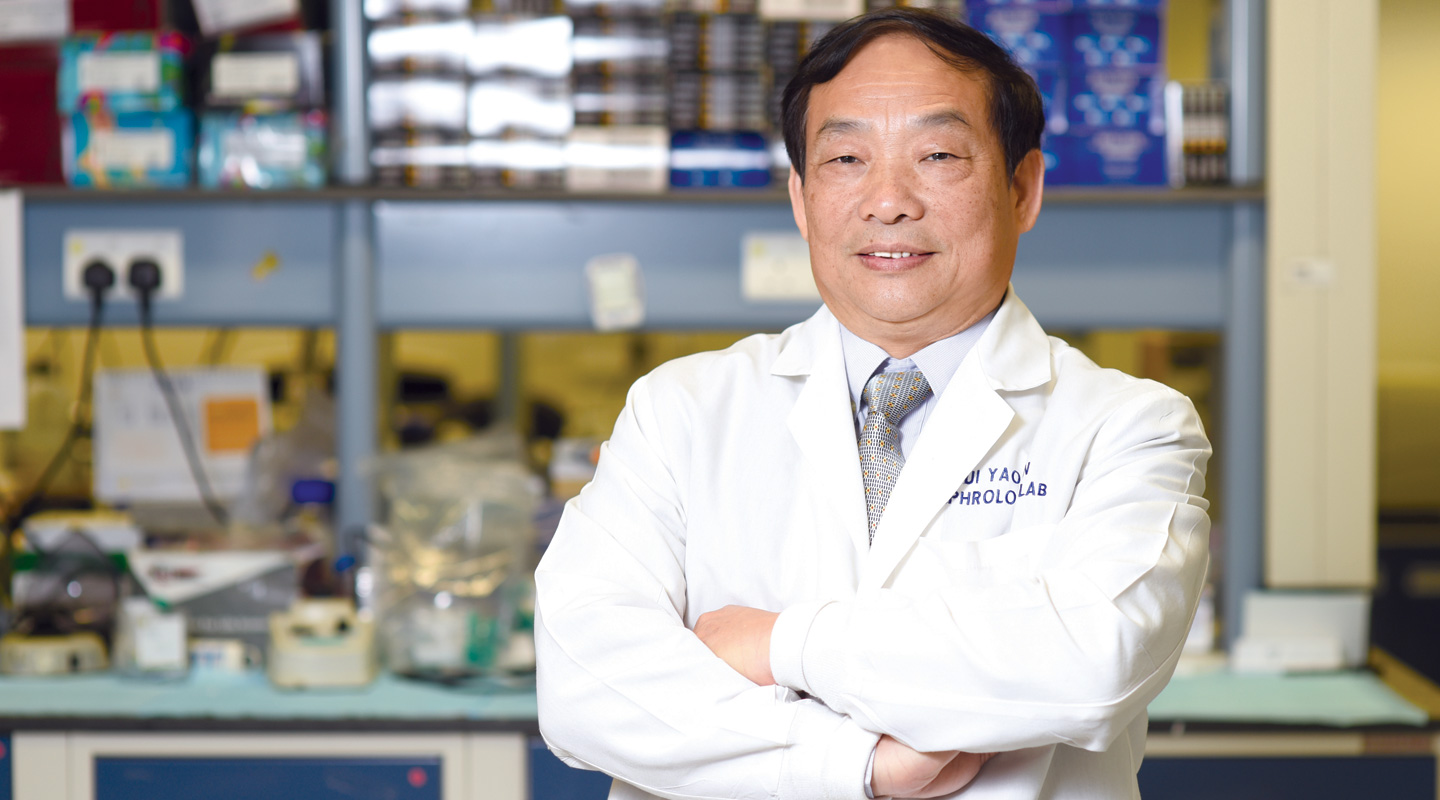Dear readers, With the launch of e-newsletter CUHK in Focus, CUHKUPDates has retired and this site will no longer be updated. To stay abreast of the University’s latest news, please go to https://focus.cuhk.edu.hk. Thank you.
Shedding Light on Renal Failure
Prof. Lan Hui-yao expounds on how he applies the yin-yang balance theory to uncover the mechanism of renal fibrosis.

Prof. Lan Hui-yao
- Choh-Ming Li Professor of Biomedical Sciences
- Awarded First Prize in Chinese Medical Science and Technology Award for his project entitled ‘Research into the Mechanism and Control of Clinical Progression of Chronic Kidney Diseases’
Please briefly introduce your award-winning research project.
When fibrosis occurs in human tissues, the scarring that ensues can damage the tissues, causing them to gradually lose their functions. This is followed by organ failure, such as that of the heart, lungs, liver and kidneys. Through my years of research, I have found that TGF-β1/Smad signalling pathway plays a critical role in tissues scar formation. This research project marks our collaboration with Southern Medical University, Southeast University, Shandong University, Kunming Institute of Botany of the Chinese Academy of Sciences and Fudan University. Together, we conducted an in-depth and systematic study to find out the mechanism of renal fibrosis, with the aim of finding the right treatment.
Our research discovered that the cause of fibrosis is due to excessive Smad3 molecules in the TGF-β1/Smad signalling pathway, while Smad7 molecules, a protector from fibrosis, are missing. From a traditional Chinese medicine (TCM) perspective, the cause can be attributed to an imbalance of a strong yang (Smad3) and a weak yin (Smad7). We also found that Smad3 can be inhibited by naringenin, commonly found in citrus peel. Asiatic acid, used by TCM practitioners to facilitate blood circulation and reduce inflammation, can stimulate Smad7 production. Combining these two in medicine can be expected to offer a new treatment for chronic renal disease.
What made you think of applying TCM theory for treatment?
Based on my pathological research over many years, ‘imbalance’ is the primary cause of disease. TCM theory emphasizes a yin-yang balance. Treatment for ‘imbalance’ can be achieved through harmonious coordination of the body’s vital organs.
This research project received the Higher Education Outstanding Scientific Research Output Awards from the Ministry of Education last year. What does winning another award mean to you?
There is no end or shortcut in research. The deeper you probe, the more issues you will uncover. Winning an award doesn’t signify an end in our work but is a driving force impelling us to embark on the next stage of research. The award we received last year was a recognition of the work of our CUHK research team, whereas the award conferredto the project this year honours the combined hard work of CUHK and several universities on the mainland.
What will you be working on next?
We plan to use our research in clinical practices to develop anti-fibrosis medicine and treatments, with a focus on formulating naringenin and Asiatic acid compound prescriptions. In the process, we discovered that TGF-β1/Smad signalling imbalance leads to the loss of the body’s tumour-fighting ability. This pointed to a new research direction──the function and mechanism of TGFβ1/Smad in the tumour microenvironment.
What made you specialize in renal disease research?
At the time when I graduated from the Zhongshan School of Medicine in Guangzhou, nephrology had not yet developed into a medical speciality on the mainland. Upon invitation, I became involved in setting up and developing the nephrology department and from then on, started to engage in nephrology research. Furthermore, renal disease is one of the major threats to human health. End-stage patients are required to undergo peritoneal dialysis (popularly known as cleansing the abdomen) or kidney transplant to prolong their lives. So this problem merits serious medical attention.
As a medical graduate, why did you not choose to practise medicine but take up research and education as your lifelong career?
In my clinical practice, I found that chronic diseases are invariably linked to scarred tissues, but how the scars are formed still remains a mystery. Subsequently, I switched to research work to unravel the causes, hoping to produce effective treatments from R&D work. After graduation, I started teaching and it made me realize that through teaching, I could pass on my insights and vision and magnify their impact. This is why I have incorporated a dual emphasis on research and teaching into my lifelong goal. Over the past 20 years, I have groomed over 80 PhD students and post-doctoral fellows in Australia, the US and Hong Kong. Many of them now hold leadership roles in specialist medical disciplines in various parts of the world. They must also be credited for the outstanding research work we produced together in the past. It is gratifying to witness their professional growth and excellent accomplishments and this is the greatest joy of my life.
This article was originally published in No. 475, Newsletter in Apr 2016.
Read More: